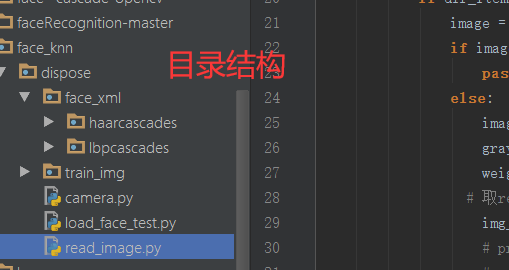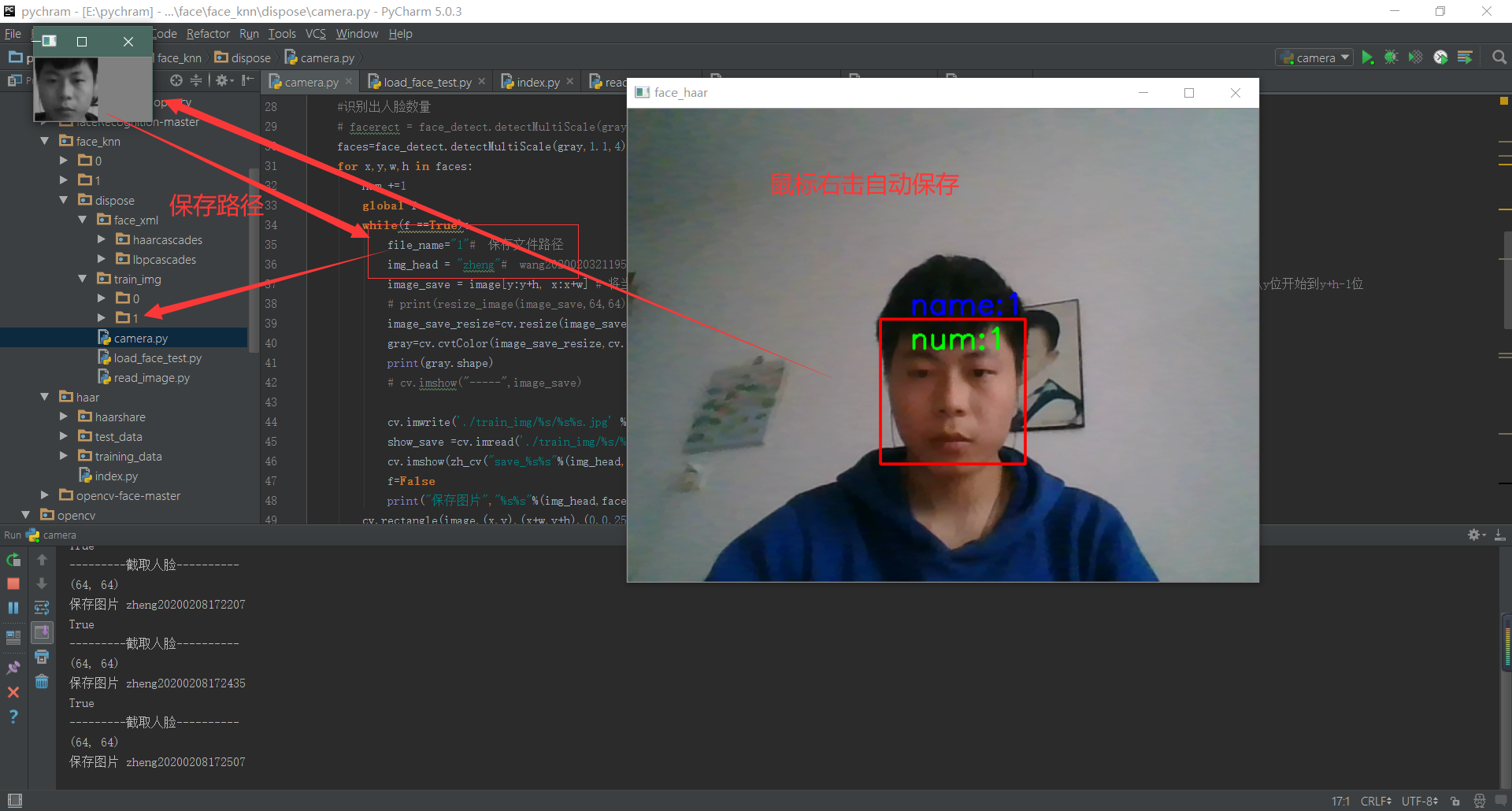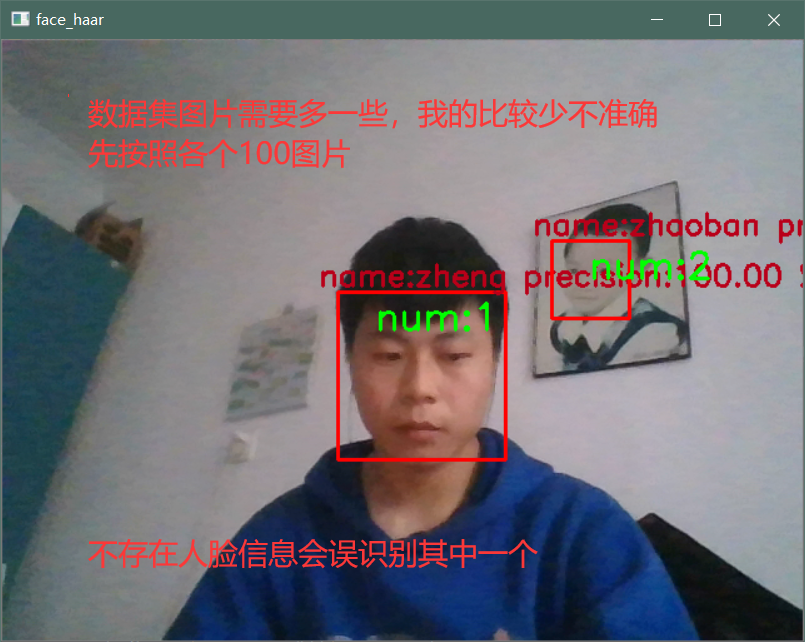python人脸识别
需要掌握知识python,opencv和机器学习一类的基础
过一段时间代码上传github,本人菜j一个,虽然是我自己写的,也有好多不懂,或者我这就是错误方向
链接:https://pan.baidu.com/s/15IK5RWrRAr_wNLFreuK7VQ 提取码:ykkn
人脸识别的步骤:
人脸检测
haar人脸检测,
lbp人脸检测
特征处理
图片大小尺寸统一
彩色灰度转换
图片编成一维矩阵
特征提取处理
归一化
特征选择-删除低方差的特征
分析进行特征降维
训练集与测试集以一定比例数据分割
预测与训练
朴素贝叶斯算法的预测
决策树进行预测
K-近邻预测
得出准确率
程序运行:自己安装调用的库

camera.py 运行会调用笔记本摄像头,鼠标右击会保存摄像头检测的人脸,保存到0和1文件夹,但是保存文件的路径需要自己手改

read_image 会调用保存两个文件夹采集的人脸数据图片,test_pre方法读取的图片路径使用自己人脸照片(属于上面采集两个人脸之一)
load_face_test.py 是把俩个程序结合出来,再有人脸数据集和haarcascades和lbp(opencv自带人脸检测网上可下就是慢,lbp是对比用的,我这里最后没有使用)

# camera.py 运行会调用笔记本摄像头,鼠标右击会保存摄像头检测的人脸,保存到0和1文件夹,但是保存文件的路径需要自己手改
import cv2 as cv
import time
def zh_cv(string):
return string.encode("gbk").decode(errors="ignore")
def get_video():
capture =cv.VideoCapture()# VideoCapture() 开发默认摄像头,如果你有多个摄像头可以试试除0之外的其他参数
print("-----打开摄像头--------")
while(capture.isOpened()) : ret, frame=capture.read()
if ret ==False : break;
# print(frame)
cv.flip(frame,)# 左右变换
# print("---------haar检测算法----------")
face_detect_dome(frame)
# face_lbp_dome(frame)
# cv.imshow("voide",frame)
# cv.imshow(zh_cv("摄像头"),frame)
c=cv.waitKey()
if c == :
break;
def face_detect_dome(image):
num =
gray=cv.cvtColor(image,cv.COLOR_BGR2GRAY)
face_detect=cv.CascadeClassifier("./face_xml/haarcascades/haarcascade_frontalface_alt.xml")
#识别出人脸数量
# facerect = face_detect.detectMultiScale(gray, scaleFactor=1.2, minNeighbors=, minSize=(, ))
faces=face_detect.detectMultiScale(gray,1.1,)
for x,y,w,h in faces:
num +=
global f
while(f ==True):
file_name=""# 保存文件路径
img_head = "zheng"# wang20200203211958
image_save = image[y:y+h, x:x+w] # 将当前帧含人脸部分保存为图片,注意这里存的还是彩色图片,前面检测时灰度化是为了降低计算量;这里访问的是从y位开始到y+h-1位
# print(resize_image(image_save,,))
image_save_resize=cv.resize(image_save,(,))
gray=cv.cvtColor(image_save_resize,cv.COLOR_BGR2GRAY)# 灰度
print(gray.shape)
# cv.imshow("-----",image_save) cv.imwrite('./train_img/%s/%s%s.jpg' %(file_name,img_head,face_time()), gray)
show_save =cv.imread('./train_img/%s/%s%s.jpg' %(file_name,img_head,face_time()))
cv.imshow(zh_cv("save_%s%s"%(img_head,face_time())),show_save)
f=False
print("保存图片","%s%s"%(img_head,face_time()))
cv.rectangle(image,(x,y),(x+w,y+h),(,,),)
# 原图 位置 ,h 颜色
# cv.namedWindow("face lbp",cv.WINDOW_NORMAL) # 显示当前捕捉到了多少人脸图片了
font = cv.FONT_HERSHEY_SIMPLEX
cv.putText(image, 'num:%d' % (num), (x + , y + ), font, , (, , ), )
cv.putText(image, 'name:%d' % (num), (x + , y -), font, , (, , ), )
# cv.namedWindow("face_haar",cv.WINDOW_NORMAL)
cv.setMouseCallback('face_haar',img_save)
cv.imshow("face_haar",image) def face_lbp_dome(image):
gray=cv.cvtColor(image,cv.COLOR_BGR2GRAY)
face_detect=cv.CascadeClassifier("./face_xml/lbpcascades/lbpcascade_frontalface.xml")
faces=face_detect.detectMultiScale(gray,1.1,)
print("---------lbp----------")
for x,y,w,h in faces:
cv.rectangle(image,(x,y),(x+w,y+h),(,,),)
# 原图 位置 w,h 颜色
cv.namedWindow("face_lbp",cv.WINDOW_NORMAL)
cv.setMouseCallback('face_lbp',img_save)
cv.imshow("face_lbp",image) def img_save(event, x, y, flags, param):
global f
if event == cv.EVENT_RBUTTONDOWN:
f = True
print(f)
print("---------截取人脸----------")
# cv.waitKey()
def face_time():
# print(time.strftime("%Y%m%d%H%M%S", time.localtime()))
n_time =str(time.strftime("%Y%m%d%H%M%S", time.localtime()))
return n_time
if __name__ == '__main__':
f = False
get_video()
#read_image 会调用保存两个文件夹采集的人脸数据图片,test_pre方法读取的图片路径使用自己人脸照片(属于上面采集两个人脸之一)
import os
from sklearn.preprocessing import MinMaxScaler, StandardScaler
from sklearn.decomposition import PCA
import numpy as np
from sklearn.model_selection import train_test_split, GridSearchCV
from sklearn.preprocessing import StandardScaler
from sklearn.naive_bayes import MultinomialNB
import cv2
images = []
labels = []
img_list =[]
# path_name是当前工作目录,后面会由os.getcwd()获得
def read_path(path_name):
for dir_item in os.listdir(path_name): # os.listdir() 方法用于返回指定的文件夹包含的文件或文件夹的名字的列表
# 从当前工作目录寻找训练集图片的文件夹
full_path = os.path.abspath(os.path.join(path_name, dir_item))
if os.path.isdir(full_path): # 如果是文件夹,继续递归调用,去读取文件夹里的内容
read_path(full_path)
else: # 如果是文件了
if dir_item.endswith('.jpg'):
image = cv2.imread(full_path)
if image is None: # 遇到部分数据有点问题,报错'NoneType' object has no attribute 'shape'
pass
else:
image_resize=cv2.resize(image,(,))
gray=cv2.cvtColor(image_resize,cv2.COLOR_BGR2GRAY)# 灰度
weight,height = gray.shape
# 取reshape后的矩阵的第一维度数据,即所需要的数据列表
img_reshape = gray.reshape(,weight*height)[]
# print(list(img_reshape))
# 转换列表添加images
image_list=list(img_reshape)
images.append(image_list)
# global labels
labels.append(path_name)
# 标注数据,me文件夹下是我,指定为0,其他指定为1,这里的0和1不是logistic regression二分类输出下的0和1,而是softmax下的多分类的类别
label = np.array(["%s"%"zhaoban" if label.endswith("%d"%) else "unknow" for label in labels])
# label = np.array([endwith(labels)])
return images,label def mm(img_mm):
"""
归一化处理
:return: NOne
"""
mm = MinMaxScaler(feature_range=(,))
data = mm.fit_transform(img_mm)
print(data)
print("----------归一化处理-------------")
return data
def pca(img_pca):
"""
主成分分析进行特征降维
:return: None
"""
pca = PCA(n_components=0.9)
data = pca.fit_transform(img_pca)
print("------------主成分分析进行特征降维---------------")
# print(data)
return data
def stand(stand_data):
"""
标准化缩放
:return:
"""
std = StandardScaler() data = std.fit_transform(stand_data) # print(data) return data
def naviebayes(data,target):
"""
朴素贝叶斯进行文本分类
:return: None,t
"""
# news = fetch_20newsgroups(subset='all')
# 进行数据分割
x_train, x_test, y_train, y_test = train_test_split(data,target, test_size=0.25) mlt = MultinomialNB(alpha=1.0)
mlt.fit(x_train, y_train)
# print(x_test)
# print(test_pre())
y_predict = mlt.predict(test_pre())
print("分类类别为:", y_predict)
# # 得出准确率
print("准确率为:", mlt.score(x_test, y_test))
return None
def test_pre():
image_test =[]
image =cv2.imread("qq.jpg")
image_resize=cv2.resize(image,(,))
gray=cv2.cvtColor(image_resize,cv2.COLOR_BGR2GRAY)# 灰度
weight,height = gray.shape
# 取reshape后的矩阵的第一维度数据,即所需要的数据列表
img_reshape = gray.reshape(,weight*height)[]
# print(list(img_reshape))
# 转换列表添加images
image_list=list(img_reshape)
image_test.append(image_list)
return image_test if __name__ == "__main__":
# print(read_path("./train_img/"))
images ,labels= read_path("./train_img/") # image_mm =mm(images)
# image_stand =stand(image_mm)
# image_pca=pca(image_mm)
print("---------------------------------------")
naviebayes(images,labels)
print("-----------------")
#load_face_test.py 是把俩个程序结合出来,再有人脸数据集和haarcascades和lbp(opencv自带人脸检测网上可下就是慢,lbp是对比用的,我这里最后没有使用)
import cv2 as cv
import time
import os
from sklearn.preprocessing import MinMaxScaler, StandardScaler
from sklearn.decomposition import PCA
import numpy as np
from sklearn.model_selection import train_test_split, GridSearchCV
from sklearn.preprocessing import StandardScaler
from sklearn.naive_bayes import MultinomialNB import cv2
images = []
labels = []
img_list =[]
# path_name是当前工作目录,后面会由os.getcwd()获得
def read_path(path_name):
for dir_item in os.listdir(path_name): # os.listdir() 方法用于返回指定的文件夹包含的文件或文件夹的名字的列表
# 从当前工作目录寻找训练集图片的文件夹
full_path = os.path.abspath(os.path.join(path_name, dir_item))
if os.path.isdir(full_path): # 如果是文件夹,继续递归调用,去读取文件夹里的内容
read_path(full_path)
else: # 如果是文件了
if dir_item.endswith('.jpg'):
image = cv2.imread(full_path)
if image is None: # 遇到部分数据有点问题,报错'NoneType' object has no attribute 'shape'
pass
else:
image_resize=cv2.resize(image,(,))
gray=cv2.cvtColor(image_resize,cv2.COLOR_BGR2GRAY)# 灰度
weight,height = gray.shape
# 取reshape后的矩阵的第一维度数据,即所需要的数据列表
img_reshape = gray.reshape(,weight*height)[]
# print(list(img_reshape))
# 转换列表添加images
image_list=list(img_reshape)
images.append(image_list)
# global labels
labels.append(path_name)
# 标注数据,me文件夹下是我,指定为0,其他指定为1,这里的0和1不是logistic regression二分类输出下的0和1,而是softmax下的多分类的类别
# dict ={:"办",:"long"}
# for key in range():
# print(dict[key])
label = np.array(["%s"%"zheng" if label.endswith("%d"%) else "zhaoban" for label in labels])
# label = np.array(["%s"%dict[i] if label.endswith("%d"%(i for i in range())) for label in labels])
return images,label def mm(img_mm):
"""
归一化处理
:return: NOne
"""
mm = MinMaxScaler(feature_range=(,))
data = mm.fit_transform(img_mm)
print(data)
print("----------归一化处理-------------")
return data
def pca(img_pca):
"""
主成分分析进行特征降维
:return: None
"""
pca = PCA(n_components=0.9)
data = pca.fit_transform(img_pca)
print("------------主成分分析进行特征降维---------------")
# print(data)
return data
def stand(stand_data):
"""
标准化缩放
:return:
"""
std = StandardScaler()
data = std.fit_transform(stand_data)
# print(data)
return data
def naviebayes(data,target,test_img):
"""
朴素贝叶斯进行文本分类
:return: None,t
"""
# news = fetch_20newsgroups(subset='all')
# 进行数据分割
x_train, x_test, y_train, y_test = train_test_split(data,target, test_size=0.25) mlt = MultinomialNB(alpha=1.0)
mlt.fit(x_train, y_train)
# print(x_test)
# print(test_pre())
y_predict = mlt.predict(test_img)
print("分类类别为:", y_predict)
# # 得出准确率
print("准确率为:", mlt.score(x_test, y_test))
return y_predict,mlt.score(x_test, y_test)
def test_pre(gray):
image_test =[]
weight,height = gray.shape
# 取reshape后的矩阵的第一维度数据,即所需要的数据列表
img_reshape = gray.reshape(,weight*height)[]
# print(list(img_reshape))
# 转换列表添加images
image_list=list(img_reshape)
image_test.append(image_list)
return image_test def zh_cv(string):
return string.encode("gbk").decode(errors="ignore")
def get_video():
capture =cv.VideoCapture()# VideoCapture() 开发默认摄像头,如果你有多个摄像头可以试试除0之外的其他参数
print("-----打开摄像头--------")
while(capture.isOpened()) :
ret, frame=capture.read()
if ret ==False : break;
# print(frame)
cv.flip(frame,)# 左右变换
# print("---------haar检测算法----------")
face_detect_dome(frame) # face_lbp_dome(frame)
# cv.imshow("voide",frame)
# cv.imshow(zh_cv("摄像头"),frame)
c=cv.waitKey()
if c == :
break; def face_detect_dome(image):
num =
gray=cv.cvtColor(image,cv.COLOR_BGR2GRAY)
face_detect=cv.CascadeClassifier("./face_xml/haarcascades/haarcascade_frontalface_alt.xml")
#识别出人脸数量
# facerect = face_detect.detectMultiScale(gray, scaleFactor=1.2, minNeighbors=, minSize=(, ))
faces=face_detect.detectMultiScale(gray,1.1,)
for x,y,w,h in faces:
num +=
image_save = image[y:y+h, x:x+w] # 将当前帧含人脸部分保存为图片,注意这里存的还是彩色图片,前面检测时灰度化是为了降低计算量;这里访问的是从y位开始到y+h-1位++
# print(resize_image(image_save,,))
image_save_resize=cv.resize(image_save,(,))
gray=cv.cvtColor(image_save_resize,cv.COLOR_BGR2GRAY)# 灰度
predict,score =naviebayes(images,labels,test_pre(gray))
print(score)
global f
# while(f ==True):
# file_name=""
# img_head = "wang"# wang20200203211958
# print(gray.shape)
# cv.imwrite('./train_img/%s/%s%s.jpg' %(file_name,img_head,face_time()), gray)
# show_save =cv.imread('./train_img/%s/%s%s.jpg' %(file_name,img_head,face_time()))
# cv.imshow(zh_cv("save_%s%s"%(img_head,face_time())),show_save)
# f=False
# print("保存图片","%s%s"%(img_head,face_time())) # image_test =cv.imread('./train_img/%s/%s%s.jpg' %(file_name,img_head,face_time())) # cv.imshow("-----",image_save)
cv.rectangle(image,(x,y),(x+w,y+h),(,,),)
# 原图 位置 ,h 颜色
# cv.namedWindow("face lbp",cv.WINDOW_NORMAL) # 显示当前捕捉到了多少人脸图片了
font = cv.FONT_HERSHEY_SIMPLEX
cv.putText(image, 'num:%d' % (num), (x + , y + ), font, , (, , ), )
cv.putText(image, 'name:%s precision:%3.2f %%' % (predict[],score*),(x -, y -), font, 0.8, (, , ), )
#cv.namedWindow("face_haar",cv.WINDOW_NORMAL)
cv.setMouseCallback('face_haar',img_save)
cv.imshow("face_haar",image) def face_lbp_dome(image):
gray=cv.cvtColor(image,cv.COLOR_BGR2GRAY)
face_detect=cv.CascadeClassifier("./face_xml/lbpcascades/lbpcascade_frontalface.xml")
faces=face_detect.detectMultiScale(gray,1.1,)
print("---------lbp----------")
for x,y,w,h in faces:
cv.rectangle(image,(x,y),(x+w,y+h),(,,),)
# 原图 位置 w,h 颜色
cv.namedWindow("face_lbp",cv.WINDOW_NORMAL)
cv.setMouseCallback('face_lbp',img_save)
cv.imshow("face_lbp",image) def img_save(event, x, y, flags, param):
global f
if event == cv.EVENT_RBUTTONDOWN:
f = True
print(f)
print("---------截取人脸----------")
# cv.waitKey()
def face_time():
# print(time.strftime("%Y%m%d%H%M%S", time.localtime()))
n_time =str(time.strftime("%Y%m%d%H%M%S", time.localtime()))
return n_time if __name__ == '__main__':
f = False
images ,labels= read_path("./train_img/")
get_video()
python人脸识别的更多相关文章
- Python人脸识别最佳教材典范,40行代码搭建人脸识别系统!
Face Id是一款高端的人脸解锁软件,官方称:"在一百万张脸中识别出你的脸."百度.谷歌.腾讯等各大企业都花费数亿来鞭策人工智能的崛起,而实际的人脸识别技术是否有那么神奇? 绿帽 ...
- 【python人脸识别】使用opencv识别图片中的人脸
概述: OpenCV是一个基于BSD许可(开源)发行的跨平台计算机视觉库 为什么有OpenCV? 计算机视觉市场巨大而且持续增长,且这方面没有标准API,如今的计算机视觉软件大概有以下三种: 1.研究 ...
- Python人脸识别 + 手机推送,老板来了你就会收到短信提示
- 总结几个简单好用的Python人脸识别算法
原文连接:https://mp.weixin.qq.com/s/3BgDld9hILPLCIlyysZs6Q 哈喽,大家好. 今天给大家总结几个简单.好用的人脸识别算法. 人脸识别是计算机视觉中比较常 ...
- OpenCV+python 人脸识别
首先给大家推荐一本书:机器学习算法原理与编程实践 本文内容全部转载于书中,相当于一个读书笔记了吧 绪论 1992年麻省理工学院通过实验对比了基于结构特征的方法与基于模版匹配的方法,发现模版匹配的方法要 ...
- 简单的 Python 人脸识别实例
案例一 导入图片 思路: 1.导入库 2.加载图片 3.创建窗口 4.显示图片 5.暂停窗口 6.关闭窗口 # 1.导入库 import cv2 # 2.加载图片 img = cv2.imread(' ...
- python人脸识别项目face-recognition
该项目基于Github上面的开源项目人脸识别face-recognition,主要是对图像和视频中的人脸进行识别,在开源项目给出的例子基础上对视频人脸识别的KNN算法进行了实现. 0x1 工程项目结构 ...
- python 人脸识别试水(一)
1.安装python,在这里我的版本是python 3.6 2.安装pycharm,我的版本是pycharm 2017 3.安装pip pip 版本10 4.安装 numpy :pip ins ...
- python 人脸识别
"""Performs face alignment and calculates L2 distance between the embeddings of image ...
随机推荐
- $Noip2010/Luogu1525$ 关押罪犯 贪心
$Luogu$ $Sol$ 贪心.尽量把怨气值大的罪犯放到两个监狱,所以首先要按照怨气值从大到小排序.当扫描到两个罪犯已经被指定到同一个监狱时,就结束循环,这个怨气值就是答案.当然把怨气值大的两个罪犯 ...
- JVM探秘:垃圾收集算法
本系列笔记主要基于<深入理解Java虚拟机:JVM高级特性与最佳实践 第2版>,是这本书的读书笔记. 垃圾收集算法 垃圾收集算法主要有标记-清除算法.复制算法.标记-整理算法.分代收集算法 ...
- 软考网络工程师、软件设计师等官方指定教材pdf文件
软考计算机网络工程师教材pdf 链接:https://pan.baidu.com/s/1-UXeNye414UWYxYRC6bHuA 提取码:5z9w 软考计算机软件设计师第五版pdf 链接:http ...
- 1076 Wifi密码 (15 分)C语言
下面是微博上流传的一张照片:"各位亲爱的同学们,鉴于大家有时需要使用 wifi,又怕耽误亲们的学习,现将 wifi 密码设置为下列数学题答案:A-1:B-2:C-3:D-4:请同学们自己作答 ...
- CF749D Leaving Auction set排序查找
CodeForces 749D. Leaving Auction 传送门 There are n people taking part in auction today. The rules of a ...
- layui下拉选择框select不显示
弹层layer下拉框没有样式_不可点击_没有效果_渲染失效的解决办法 一.必须给表单体系所在的父元素加上 class="layui-form" 在一个容器中设定 class=&qu ...
- Android学习进度一
在解决了电脑产生的一系列问题之后成功安装了Android Studio,并在其自带的手机模拟器上成功运行了第一个App(Hello World!),通过这个最简单的App研究了App基本的工程结构,为 ...
- 【C&数据结构】---关于链表结构的前序插入和后序插入
刷LeetCode题目,需要用到链表的知识,忽然发现自己对于链表的插入已经忘得差不多了,以前总觉得理解了记住了,但是发现真的好记性不如烂笔头,每一次得学习没有总结输出,基本等于没有学习.连复盘得机会都 ...
- 简单 hash 入门题目
题目描述 NOIP 复赛之前,HSD 桑进行了一项研究,发现人某条染色体上的一段 DNA 序列中连续的 kkk 个碱基组成的碱基序列与做题的 AC 率有关!于是他想研究一下这种关系.现在给出一段 DN ...
- sql if else 语句
IF ELSE 语句IF ELSE 是最基本的编程语句结构之一几乎每一种编程语言都支持这种结构而它在用于对从数据库返回的数据进行检查是非常有用的TRANSACT-SQL 使用IF ELSE的例子如下语 ...
